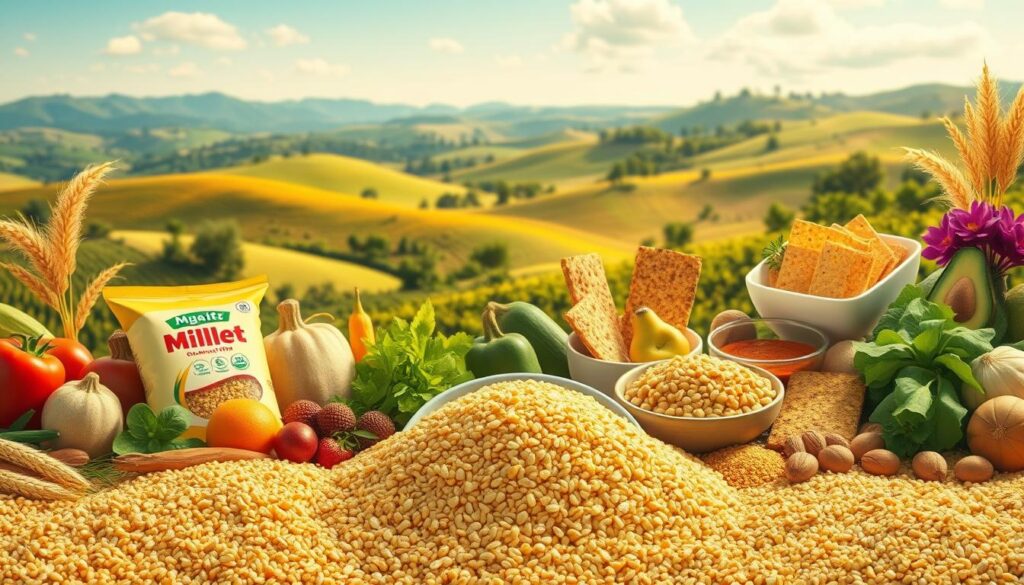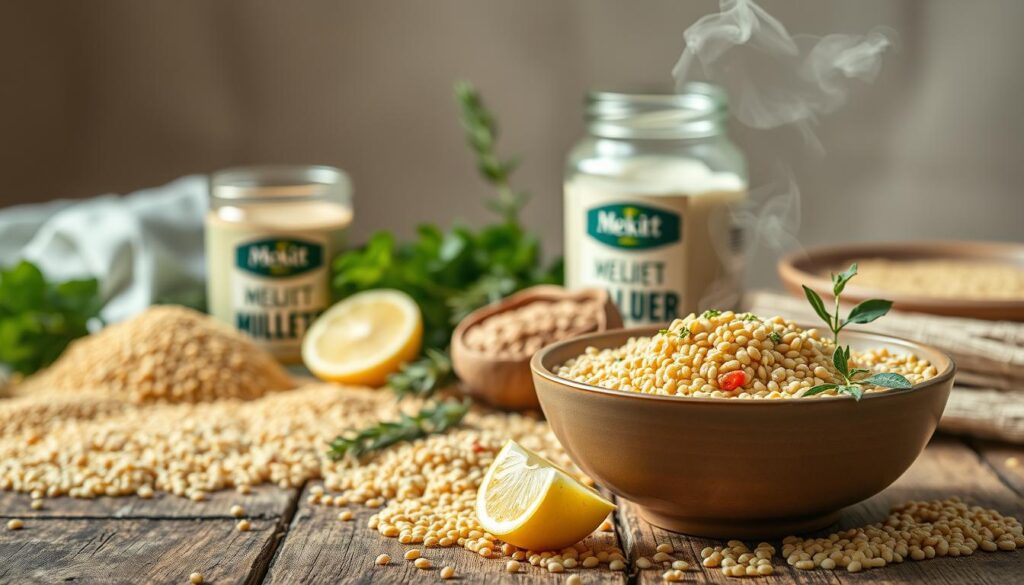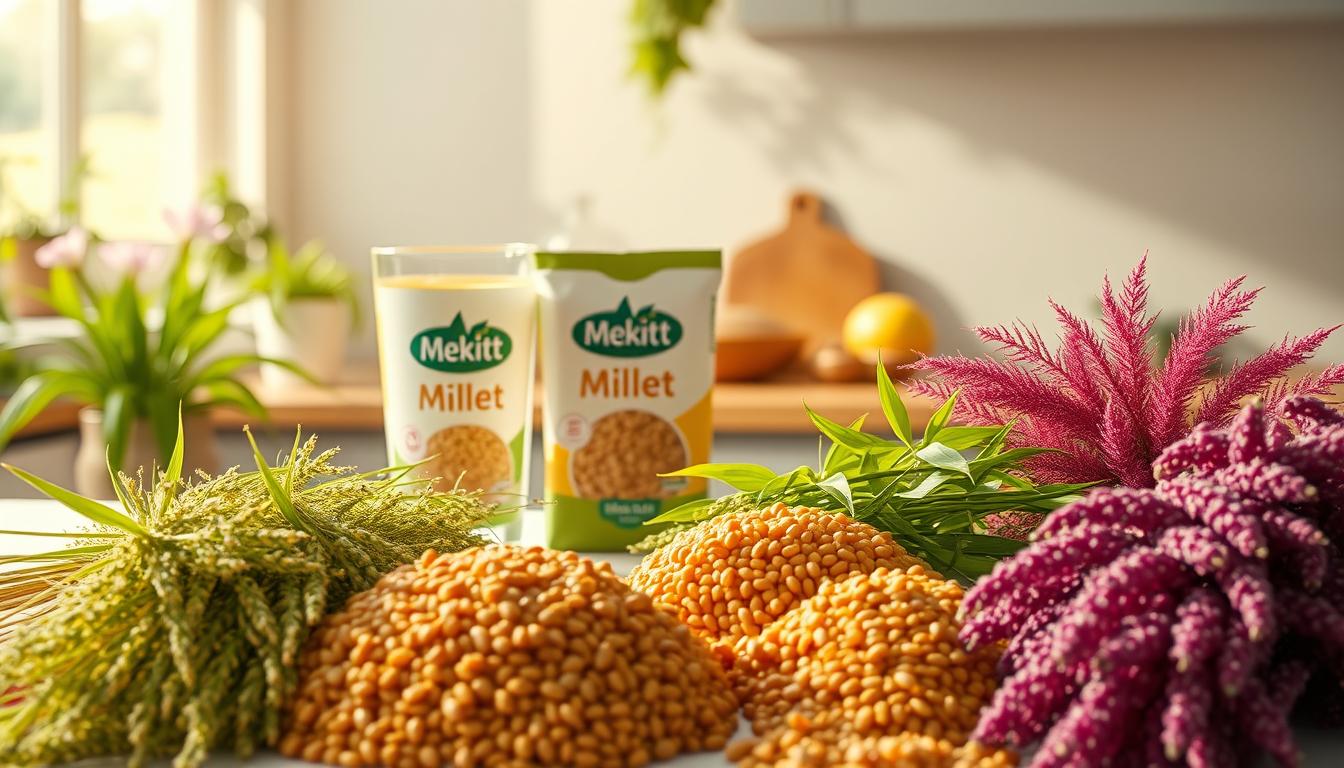Have we forgotten that simple grains from our farms can help us feel lighter, more energetic, and steadier in blood sugar?
We wrote this guide because we believe small, steady changes transform health. We are a community of home cooks and nutrition lovers helping each other learn about eating millets daily without fuss. This is for people in India who want a realistic millet diet plan that fits family meals and busy lives.
Millets are small-seeded whole grains—pearl, finger, foxtail, barnyard, little millet, kodo, and proso—that have nourished Indian households for centuries. They are simple to cook and rich in fiber, minerals, and slow-release energy. In this guide we explain the benefits of eating millets and show how to replace some refined grains with millets to improve digestion, support weight management, and help stabilize blood sugar.
What follows is a clear roadmap: we cover nutrition and health benefits, simple steps to begin, easy cooking methods, a beginner-friendly millet diet plan, quick recipes, and practical daily tips for shopping and storage. Each part gives hands-on ideas—meal swaps, portion hints, batch-cooking tips, and ways to track how your body responds.
We promise gentle, evidence-informed advice grounded in whole-grain nutrition and traditional practices. No heavy jargon—just warm, practical steps you can try this week. Start small, keep track of energy and digestion, and invite the family along. This is how to start eating millets daily for better health—one tasty plate at a time.
Why Choose Millets: Benefits of Eating Millets and Whole Grain Nutrition
We often seek simple ways to boost nutrition and fit busy lives. Millets are small but mighty, providing whole grain goodness without raising blood sugar. They’re easy to add to meals and bring back traditional tastes. Let’s dive into how millets support health and connect us to ancient food traditions.

Nutrition profile of common millets
Pearl millet (bajra) is packed with iron and magnesium, plus fiber. Finger millet (ragi) is a calcium and B vitamins powerhouse. Foxtail millet (kangni) is light, with protein and phosphorus.
Barnyard millet (sama) is low in glycemic index but high in fiber. Kodo and little millet (kutki) offer plant-based protein and micronutrients. Proso millet is easy to cook and rich in B6 and magnesium. All millets are gluten-free, adding to whole grain nutrition.
Health benefits: digestion, weight management, and blood sugar control
Millets have both soluble and insoluble fiber. This mix aids digestion and keeps the gut healthy. Meals with millets help us feel full, aiding in weight management.
The protein and fiber in millets slow digestion and reduce hunger between meals. This is great for those trying to lose weight. Many millets also have a low to moderate glycemic response, helping to stabilize blood sugar.
Environmental and cultural advantages: sustainable eating habits and ancient grains
Millets are drought-tolerant and need less water than other grains. They’ve been a staple for farmers in dry areas for centuries. Choosing millets supports diverse farming and local food security.
By eating millets, we support sustainable eating. They reduce water use and keep our plates flavorful. For many, it’s not just a trend but a return to healthier, more sustainable eating.
How to Start Eating Millets Daily for Better Health
We aim for a gentle plan that fits busy lives. Small, steady changes make it easy to learn how to eat millets. Start with goals you can hit — not big overhauls.

Setting realistic goals for replacing rice and refined grains
Begin with one millet meal a day or swap one rice or wheat meal every two days. Aim for a 25–50% replacement in the first month, then increase as you feel comfortable.
Try millet breakfast instead of white bread or refined cereal. Plan a millet khichdi for one lunch each week. Rotate foxtail, pearl, and finger millet to keep flavors fresh and nutrition varied.
Meal timing and portion tips for beginners
Use 1/3 to 1/2 cup uncooked millet per person per meal as a starter. Adjust for appetite and activity. Pair millets with protein — lentils, eggs, paneer, or yogurt — and plenty of vegetables for balance.
Space meals to steady blood sugar. Millets’ fiber helps you feel full longer and reduces mid-day energy drops. Keep snacks simple — roasted chana or a fruit with yogurt work well.
Tracking progress: digestion, energy, and satisfaction
Keep a lightweight log for 2–4 weeks. Note energy levels, hunger between meals, bowel regularity, and how satisfied you feel after millet meals. Look for fewer afternoon slumps, more regular stools, or lasting fullness.
Expect a short adjustment period — gut changes can take one to two weeks. If you have chronic conditions, check with a registered dietitian or physician before major changes.
- Cook a big batch on Sunday for easy weekday bowls.
- Make kid-friendly options — millet dosa, upma, or porridge — to involve the family.
- Celebrate small wins — one extra millet meal a week is progress.
How to Cook Millets: Easy Methods and Kitchen Tips
We aim to make cooking millets easy and enjoyable. Start by rinsing the grains under water to remove dust and starch. Simple steps like rinsing, toasting, and soaking greatly improve texture and digestion.
These stovetop guides are a great starting point. Adjust the water and cooking time to suit your taste.
- Foxtail millet: rinse well. Use a 1:2 millet-to-water ratio. Simmer 12–15 minutes. Rest covered 5–10 minutes.
- Pearl millet (bajra): rinse, then use 1:2.5 ratio. Cook 20–25 minutes. It needs longer to soften.
- Finger millet (ragi): whole grain is often ground for porridge or rotis. For porridge, start with 1:4 ratio and cook gently.
- Barnyard millet: rinse and cook in 1:2 ratio for 10–12 minutes. Fluff after a short rest.
Using a pressure cooker, rice cooker, and instant pot
Busy mornings call for quick solutions. A pressure cooker can speed up millet cooking. For foxtail, one whistle on low often works. For pearl millet, aim for two whistles or 6–8 minutes on medium pressure—test small batches to find your ideal texture.
Rice cookers handle millets like rice. Use the same water ratios and the standard cook setting. Instant Pot users can set high pressure for 8–10 minutes and use natural release for most millets. Always follow your appliance manual and note that altitude and model affect timing.
Flavoring and soaking tips to improve texture and digestion
Soaking small whole millets for 30 minutes to 2 hours shortens cook time and eases digestion. Sprouting reduces phytic acid and boosts mineral availability. Dry-toast grains for a nutty aroma before cooking.
Adding simple flavors can elevate the dish. Try adding a bay leaf, a cinnamon stick, or cumin seeds while cooking. Finish with a drizzle of ghee or olive oil. Stir in sautéed onions, grated carrots, peas, or chopped tomatoes to make easy millet recipes for breakfast and dinner that taste homey.
Store millets in airtight jars in a cool, dry place. Buy whole dehusked grains from trusted brands or local markets. Test doneness by tasting—grains should be tender but not mushy. These basic methods make millet recipes for beginners approachable and encourage experimentation with porridge, pilaf, or fluffy pilau textures.
Millet Diet Plan for Beginners: Simple Weekly Menu Ideas
We aim for a millet diet plan that suits Indian tastes. Here are some easy swaps, snack ideas, and batch-cooking tips. Use these as guides, not strict rules. Rotate millets through the week to keep meals interesting.
Begin by planning three to four millet-based meals a week. Start with small changes, like swapping rice for millets at lunch or using bajra rotis for dinner. Choose millets like ragi, foxtail, jowar, and bajra. These are great for weight loss when eaten in moderation and with protein.
For breakfast, try millet porridge with milk and fruit or millet upma instead of semolina. Lunch can be millet khichdi with dal and veggies instead of white rice. For dinner, enjoy millet dosa with sambar or a light millet pulao with cucumber raita.
- Breakfast swaps: ragi or foxtail porridge, millet upma, or bajra/jowar rotis with veggies.
- Lunch swaps: millet pulao or khichdi with dal, or a millet salad with roasted veggies and chickpeas.
- Dinner swaps: millet dosa, millet-stuffed parathas, or a quick millet khichdi with yogurt.
For snacks, pick millet-based bites that are filling but not too big. Try roasted or puffed millet, millet chivda, ragi cookies, or millet laddoos. Pair them with a protein source like yogurt, a boiled egg, or almonds to stay full.
- Snack ideas: roasted millet mix, millet chivda, ragi biscuits, or two small millet laddoos.
- Portion tips: keep snacks single-serve. A fist-sized serving for cooked millet or one small cookie per snack is a good rule.
Batch-cooking makes meal prep easy. Cook a large pot of millet and store it in the fridge for up to four days. Make a batter for dosas or uttapam and refrigerate it for two to three days. Chop veggies and boil dals in advance to speed up weekday meals.
- Batch tip 1: Cook 3–4 cups of millet and cool before refrigerating in airtight containers.
- Batch tip 2: Portion cooked millet into bowls for quick bowls, salads, or stir-fries.
- Batch tip 3: Reheat with a splash of water and cover to retain moisture.
Adjust portions based on your calorie needs and add protein-rich sides like dal, paneer, fish, or legumes. Start by replacing rice with millets in one meal a day and gradually increase. Small, steady swaps help us stick to the plan and reach our goals without feeling deprived.
Millet Recipes for Beginners: Easy Recipes for Breakfast and Dinner
We want cooking millets to feel simple and familiar. Here are friendly templates for breakfast and dinner. Use them as a starting point — tweak spices and textures to suit your family.
Quick millet porridge and upma ideas for breakfast
For a sweet start, try a quick millet porridge. Cook 1 part millet with 3 parts milk or water until soft. Mash a ripe banana, add a pinch of cardamom and a teaspoon of jaggery or honey. Stir and warm through. If the mixture is too thick, add more milk or water.
For a savory option, make millet upma. Roast millet dry for a few minutes, then sauté mustard seeds, curry leaves, chopped onion and vegetables in oil. Add rinsed millet and 2.5 parts vegetable broth. Cook until tender and finish with lemon juice and coriander. Swap vegetables seasonally to keep breakfasts fresh.
Simple millet pulao, khichdi, and rotis for dinner
Millet pulao follows a familiar formula. Sauté whole spices and onions in ghee or oil, add chopped vegetables, then rinsed millet. Pour in hot broth, simmer until the millet is tender, then fluff and rest. Serve with plain yogurt or cucumber raita.
Khichdi is gentle on digestion. Cook equal parts millet and moong dal with turmeric and enough water until soft. Add a drizzle of ghee and fresh coriander. This makes a soothing weeknight dinner.
For rotis, blend millet flour with a small portion of wheat flour or add psyllium husk for pliability. Use hot water when kneading and let the dough rest briefly. Roll thin and cook on a hot tawa — serve with dal or chutney.
One-pot and kid-friendly recipes to encourage family adoption
One-pot millet recipes make life easier. Try a vegetable millet pilaf with peas, carrots and mild spices. Cook everything in one pot and finish with a squeeze of lemon. Kids like texture—keep the grains fluffy and the veggies bite-size.
- Cheesy millet bake: mix cooked millet with vegetables, a little cheese and egg or yogurt, bake until set.
- Millet meatballs in tomato sauce: combine cooked millet with minced meat, shape, and simmer in a mild tomato sauce.
- Mini millet idlis or muffins: use a fermented or plain millet batter, pour into mini molds, steam or bake for lunchbox-friendly bites.
Introduce millets gradually — mix them with rice or wheat at first. Adjust seasoning to match family favorites. Small changes help everyone accept new flavors.
Quick troubleshooting: if porridge thickens, add warm milk. If rotis crumble, knead with hot water and rest. For fluffier millet, let it sit covered for five minutes after cooking before fluffing with a fork.
Practical Tips: How to Include Millets in Your Daily Indian Diet
We aim to make millets a daily staple in our kitchens. Start by swapping one meal a day or two meals a week. Use recipes you already know to make the transition smooth for everyone.
Here are some healthy food swaps that fit well into an Indian diet.
- Replace one cup of cooked rice with millet pulao at lunch.
- Use millet upma instead of semolina for breakfast.
- Make bajra or jowar rotis once or twice a week instead of wheat.
- Build salads on a base of cooked foxtail or barnyard millet instead of processed grains.
Start with what you know. This makes it easier for everyone to accept the change.
Balance is key. Try this simple plate composition regularly to get the right nutrients.
- One third millets, one third vegetables, one third protein—dal, paneer, eggs, or legumes.
- Use tadka—mustard seeds, cumin, curry leaves—to boost aroma and acceptance.
- Spice smartly—turmeric, coriander, and garam masala lift millets without extra effort.
- Pairing millets with dals or legumes improves the amino acid profile and makes meals more filling.
Shopping for millets doesn’t have to be hard. We use a checklist to save time and money.
- Buy from trusted brands like 24 Mantra or Tata Sampann, local organic co-ops, or reliable market vendors.
- Choose whole, dehusked grains over processed mixes for better nutrition and longer shelf life.
- Check packaging dates and avoid damp or torn bags that can hide pests.
Store millets the right way to keep them fresh and tasty.
- Keep grains in airtight containers in a cool, dry place.
- Refrigerate in humid climates to prevent rancidity.
- Use within a few months and rotate varieties to keep meals interesting.
Choose millets based on your goals. Here are some practical options.
- Ragi (finger millet) for calcium and porridge-style breakfasts.
- Foxtail and barnyard millet for a lighter texture in pulao and salads.
- Bajra and jowar for rotis when you want a robust, filling bread.
- Rotate types—this gives nutrient variety and keeps eating delightful.
We face barriers like cost, availability, and taste. Simple fixes help.
- Try affordable local millets and shop online during sales.
- Make recipes that mimic familiar textures—khichdi or upma—to ease the switch.
- Cook in batches and freeze portions for quick weekday meals.
Health matters deserve careful notes. If you have thyroid issues or other conditions, talk with a doctor before making big changes. A clinician can advise on nutrient interactions and portion changes.
Follow these steps to make millets a steady, nourishing part of your life. Small swaps, smart pairings, and thoughtful shopping turn intention into habit.
Conclusion
We’ve shown how to start eating millets daily for better health. We gave simple steps and practical tips. Millets are nutritious, support digestion, and control blood sugar.
Start small by swapping one meal with millets. Try a millet breakfast or make one millet-based dinner this week. This will help you get used to them.
Use the cooking methods and recipes we shared to make meals easy and tasty. Mix millets with lentils, paneer, fish, or vegetables for a balanced meal. Batch-cook and keep portions practical for stress-free meals.
Track how you feel as you start eating millets. Notice changes in energy, digestion, and satisfaction. Small, steady shifts add up over time.
Bookmark this guide and try two to three recipes from the section. If you need a personalized plan, consult a registered dietitian. Embracing millets supports your wellbeing and sustainable food systems in India.
We’re exploring traditional grains together. We’re making gentle swaps and enjoying nourishing meals. Let’s make millets a simple, joyful part of our daily lives.

